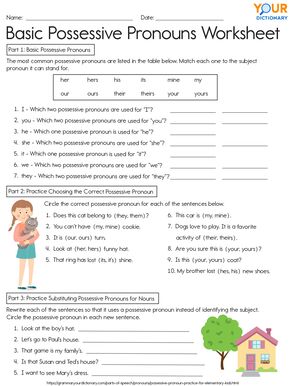

If you are looking for possessive pronoun practice for elementary school kids, then the following possessive pronouns exercises and printable worksheet will be helpful. The activities focus on the basics of possessive pronouns, including how they should be used in simple sentences.
Possessive Pronouns Practice Exercises
While the printable worksheet provided below has more practice exercises, there are a few basic items you can use with your class if you prefer not to use the full worksheet. Answers appear after the printable worksheet.
Part 1: Basic Possessive Pronouns Practice
For this exercise, put a list of the possessive pronouns (my, mine, your, yours, his, her, hers, our, ours, its, their, theirs) on the board. Explain how each one relates to a subject pronoun. Ask students to determine which possessive pronoun goes with which subject pronoun.
- I - Which two possessive pronouns are used for "I"?
- you - Which two possessive pronouns are used for "you"?
- he - Which one possessive pronoun is used for "he"?
- she - Which two possessive pronouns are used for "she"?
- it - Which possessive pronoun is used for "it"?
Part 2: Practice Choosing the Correct Possessive Pronoun
It may be helpful to review examples of possessive pronouns in sentences before working through the practice items below. Select the correct possessive pronoun for each of the following sentences:
- Is this (your, yours) coat?
- You can’t have (my, mine) cookie.
- It is (our, ours) turn.
- Look at (her, hers) funny hat.
- That ring has lost (its, it’s) shine.
Part 3: Practice Substituting Possessive Pronouns for Nouns
Assign students to rewrite the following sentences using possessive pronouns.
- Look at the boy’s hat.
- Let’s go to Paul’s house.
- That game is my family’s.
Printable Possessive Pronouns Worksheet
For an educational worksheet that helps students practice their skills with possessive pronouns, download the worksheet below. This worksheet is appropriate for use with kids in second or third grade and includes an answer key.

Answers to Pronouns Practice Exercises
Don't peek at the answers below until you (or your students) have worked through the practice questions above.
Part 1 Answers: Basic Possessive Pronouns Practice
The correct answers are bold.
- The possessive pronouns used for the subject pronoun "I" are my and mine.
- The possessive pronouns used for the subject pronoun "you" are your and yours.
- The possessive pronoun used for the subject pronoun "he" is his.
- The possessive pronouns used for the subject pronoun "she" are her and hers.
- The possessive pronoun used for the subject pronoun "it" is its.
Part 2 Answers: Practice Choosing the Correct Possessive Pronoun
The correct answers are bold.
- Is this (your, yours) coat?
- You can’t have (my, mine) cookie.
- It is (our, ours) turn.
- Look at (her, hers) funny hat.
- That ring has lost (its, it’s) shine.
Part 3 Answers: Practice Substituting Possessive Pronouns for Nouns
The rewritten sentences are below, with the possessive pronouns marked in bold.
- Look at his hat.
- Let’s go to his house.
- That game is ours.
Learn More About Possessive Pronouns
The practice items provided here are fairly basic. Once students have mastered these activities, further expand their skills with additional possessive pronouns worksheets. The more learners practice as they expand their knowledge and skills, the more proficient they'll become. Soon it will be time to move beyond possessive pronouns to focus on more advanced rules for possessive in grammar.